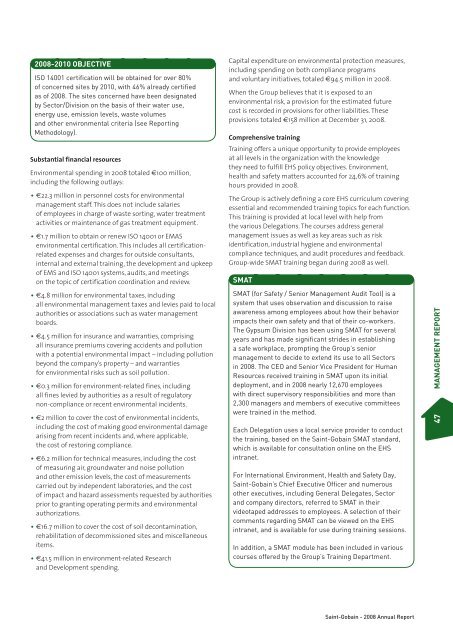sain t-gobain annu al report 2008 annual report
sain t-gobain annu al report 2008 annual report
sain t-gobain annu al report 2008 annual report
Create successful ePaper yourself
Turn your PDF publications into a flip-book with our unique Google optimized e-Paper software.
<strong>2008</strong>-2010 OBJECTIVE<br />
ISO 14001 certification will be obtained for over 80%<br />
of concerned sites by 2010, with 46% <strong>al</strong>ready certified<br />
as of <strong>2008</strong>. The sites concerned have been designated<br />
by Sector/Division on the basis of their water use,<br />
energy use, emission levels, waste volumes<br />
and other environment<strong>al</strong> criteria (see Reporting<br />
Methodology).<br />
Substanti<strong>al</strong> financi<strong>al</strong> resources<br />
Environment<strong>al</strong> spending in <strong>2008</strong> tot<strong>al</strong>ed €100 million,<br />
including the following outlays:<br />
• €22.3 million in personnel costs for environment<strong>al</strong><br />
management staff. This does not include s<strong>al</strong>aries<br />
of employees in charge of waste sorting, water treatment<br />
activities or maintenance of gas treatment equipment.<br />
• €1.7 million to obtain or renew ISO 14001 or EMAS<br />
environment<strong>al</strong> certification. This includes <strong>al</strong>l certificationrelated<br />
expenses and charges for outside consultants,<br />
intern<strong>al</strong> and extern<strong>al</strong> training, the development and upkeep<br />
of EMS and ISO 14001 systems, audits, and meetings<br />
on the topic of certification coordination and review.<br />
• €4.8 million for environment<strong>al</strong> taxes, including<br />
<strong>al</strong>l environment<strong>al</strong> management taxes and levies paid to loc<strong>al</strong><br />
authorities or associations such as water management<br />
boards.<br />
• €4.5 million for insurance and warranties, comprising<br />
<strong>al</strong>l insurance premiums covering accidents and pollution<br />
with a potenti<strong>al</strong> environment<strong>al</strong> impact – including pollution<br />
beyond the company’s property – and warranties<br />
for environment<strong>al</strong> risks such as soil pollution.<br />
• €0.3 million for environment-related fines, including<br />
<strong>al</strong>l fines levied by authorities as a result of regulatory<br />
non-compliance or recent environment<strong>al</strong> incidents.<br />
• €2 million to cover the cost of environment<strong>al</strong> incidents,<br />
including the cost of making good environment<strong>al</strong> damage<br />
arising from recent incidents and, where applicable,<br />
the cost of restoring compliance.<br />
• €6.2 million for technic<strong>al</strong> measures, including the cost<br />
of measuring air, groundwater and noise pollution<br />
and other emission levels, the cost of measurements<br />
carried out by independent laboratories, and the cost<br />
of impact and hazard assessments requested by authorities<br />
prior to granting operating permits and environment<strong>al</strong><br />
authorizations.<br />
• €16.7 million to cover the cost of soil decontamination,<br />
rehabilitation of decommissioned sites and miscellaneous<br />
items.<br />
• €41.5 million in environment-related Research<br />
and Development spending.<br />
Capit<strong>al</strong> expenditure on environment<strong>al</strong> protection measures,<br />
including spending on both compliance programs<br />
and voluntary initiatives, tot<strong>al</strong>ed €94.5 million in <strong>2008</strong>.<br />
When the Group believes that it is exposed to an<br />
environment<strong>al</strong> risk, a provision for the estimated future<br />
cost is recorded in provisions for other liabilities. These<br />
provisions tot<strong>al</strong>ed €158 million at December 31, <strong>2008</strong>.<br />
Comprehensive training<br />
Training offers a unique opportunity to provide employees<br />
at <strong>al</strong>l levels in the organization with the knowledge<br />
they need to fulfill EHS policy objectives. Environment,<br />
he<strong>al</strong>th and safety matters accounted for 24,6% of training<br />
hours provided in <strong>2008</strong>.<br />
The Group is actively defining a core EHS curriculum covering<br />
essenti<strong>al</strong> and recommended training topics for each function.<br />
This training is provided at loc<strong>al</strong> level with help from<br />
the various Delegations. The courses address gener<strong>al</strong><br />
management issues as well as key areas such as risk<br />
identification, industri<strong>al</strong> hygiene and environment<strong>al</strong><br />
compliance techniques, and audit procedures and feedback.<br />
Group-wide SMAT training began during <strong>2008</strong> as well.<br />
SMAT<br />
SMAT (for Safety / Senior Management Audit Tool) is a<br />
system that uses observation and discussion to raise<br />
awareness among employees about how their behavior<br />
impacts their own safety and that of their co-workers.<br />
The Gypsum Division has been using SMAT for sever<strong>al</strong><br />
years and has made significant strides in establishing<br />
a safe workplace, prompting the Group’s senior<br />
management to decide to extend its use to <strong>al</strong>l Sectors<br />
in <strong>2008</strong>. The CEO and Senior Vice President for Human<br />
Resources received training in SMAT upon its initi<strong>al</strong><br />
deployment, and in <strong>2008</strong> nearly 12,670 employees<br />
with direct supervisory responsibilities and more than<br />
2,300 managers and members of executive committees<br />
were trained in the method.<br />
Each Delegation uses a loc<strong>al</strong> service provider to conduct<br />
the training, based on the Saint-Gobain SMAT standard,<br />
which is available for consultation online on the EHS<br />
intranet.<br />
For Internation<strong>al</strong> Environment, He<strong>al</strong>th and Safety Day,<br />
Saint-Gobain’s Chief Executive Officer and numerous<br />
other executives, including Gener<strong>al</strong> Delegates, Sector<br />
and company directors, referred to SMAT in their<br />
videotaped addresses to employees. A selection of their<br />
comments regarding SMAT can be viewed on the EHS<br />
intranet, and is available for use during training sessions.<br />
In addition, a SMAT module has been included in various<br />
courses offered by the Group’s Training Department.<br />
MANAGEMENT REPORT<br />
47<br />
Saint-Gobain - <strong>2008</strong> Annu<strong>al</strong> Report

















